Conflict Management, Coaching, and Performance: A Detailed Analysis
VerifiedAdded on 2023/06/17
|11
|2830
|446
Essay
AI Summary
This essay examines the role of conflict management and coaching techniques in resolving conflict situations and improving individual performance, using Tesco as a case study. It identifies different types of conflicts (intrapersonal, interpersonal, intergroup, and intragroup) and stages of conflict (trigger, assumptions, labeling, attack and blaming, entrenched, and collision). The essay discusses various conflict management styles, including collaborating, competing, avoiding, accommodating, and compromising, along with conflict resolution techniques like problem-solving, compromising, avoiding, competing, and accommodating. It highlights the importance of reflective learning cycles, such as Gibb's model, in resolving conflicts and explores coaching techniques, including understanding employee perspectives, continuous learning, and the GROW model, to enhance employee performance. The assignment brief is included which covers the topic of inevitable conflict in the workplace.
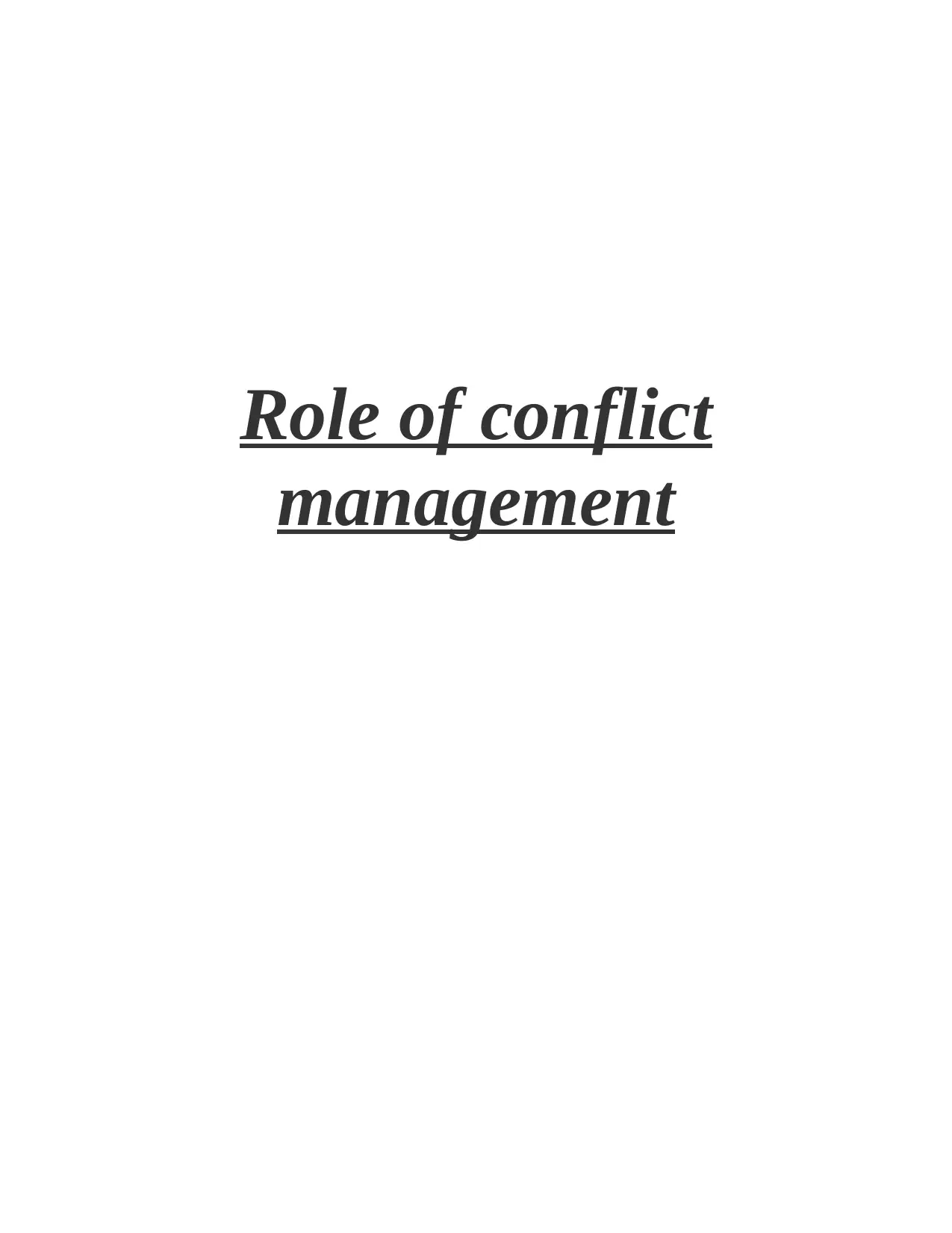
Role of conflict
management
management
Paraphrase This Document
Need a fresh take? Get an instant paraphrase of this document with our AI Paraphraser
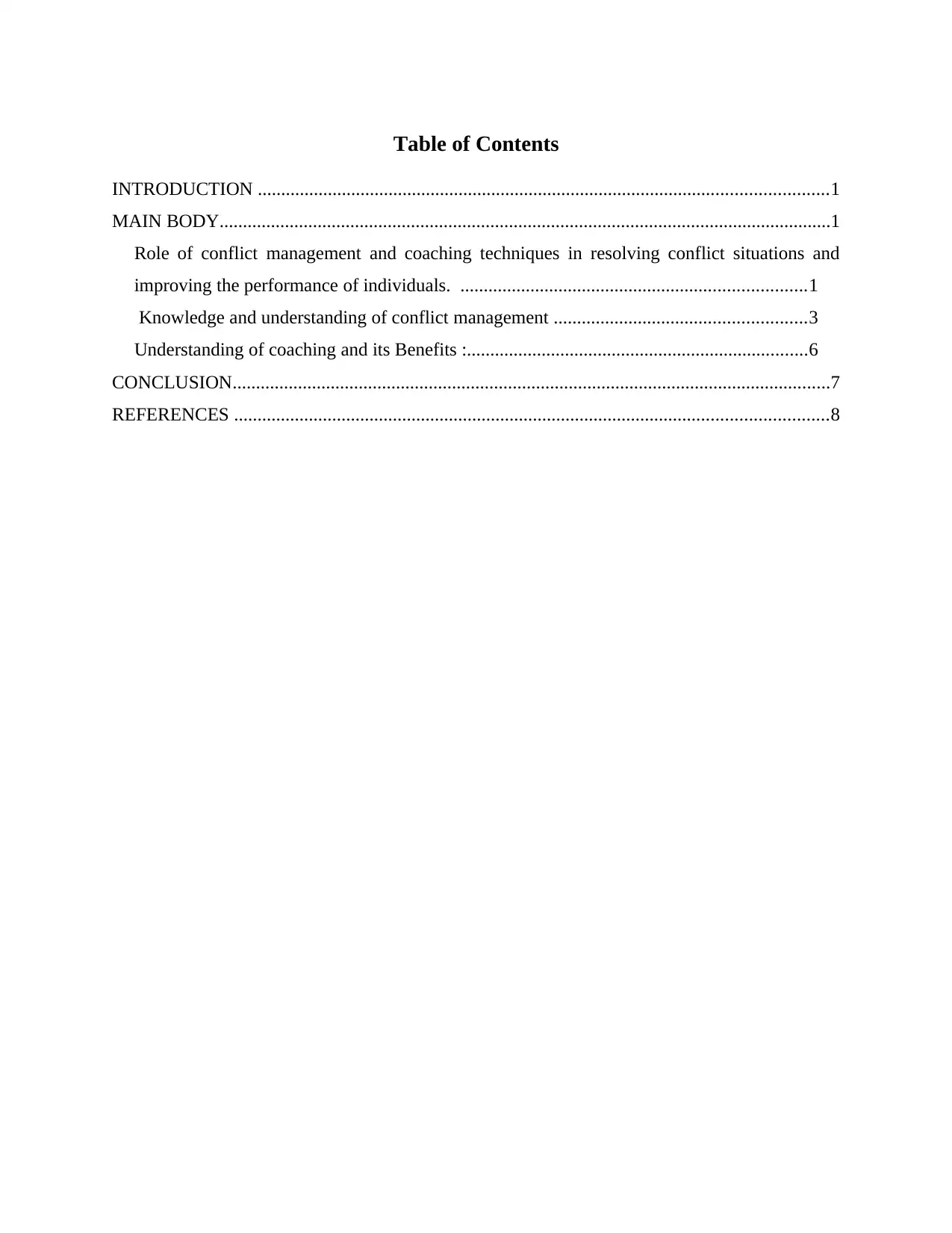
Table of Contents
INTRODUCTION ..........................................................................................................................1
MAIN BODY...................................................................................................................................1
Role of conflict management and coaching techniques in resolving conflict situations and
improving the performance of individuals. ..........................................................................1
Knowledge and understanding of conflict management ......................................................3
Understanding of coaching and its Benefits :.........................................................................6
CONCLUSION................................................................................................................................7
REFERENCES ...............................................................................................................................8
INTRODUCTION ..........................................................................................................................1
MAIN BODY...................................................................................................................................1
Role of conflict management and coaching techniques in resolving conflict situations and
improving the performance of individuals. ..........................................................................1
Knowledge and understanding of conflict management ......................................................3
Understanding of coaching and its Benefits :.........................................................................6
CONCLUSION................................................................................................................................7
REFERENCES ...............................................................................................................................8
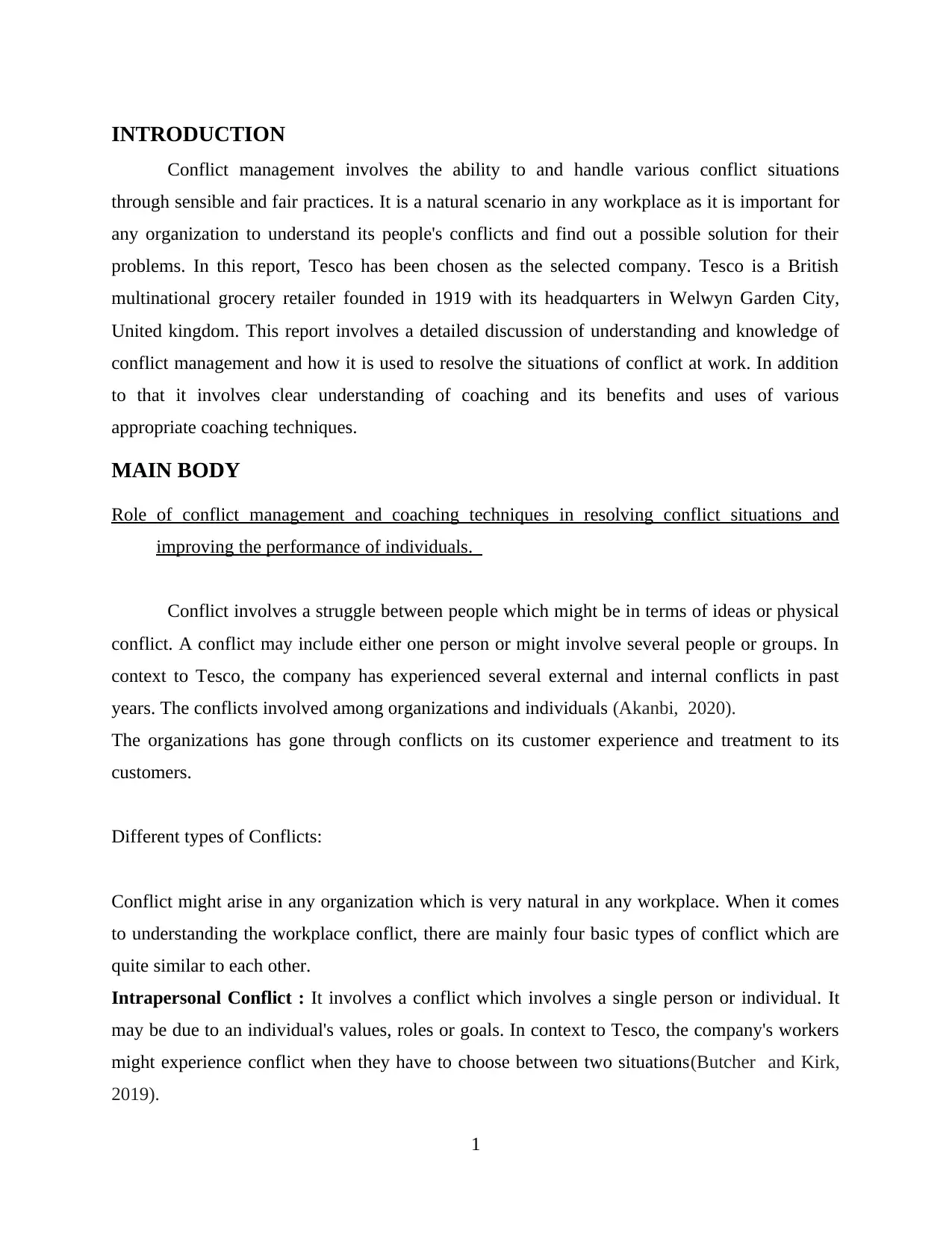
INTRODUCTION
Conflict management involves the ability to and handle various conflict situations
through sensible and fair practices. It is a natural scenario in any workplace as it is important for
any organization to understand its people's conflicts and find out a possible solution for their
problems. In this report, Tesco has been chosen as the selected company. Tesco is a British
multinational grocery retailer founded in 1919 with its headquarters in Welwyn Garden City,
United kingdom. This report involves a detailed discussion of understanding and knowledge of
conflict management and how it is used to resolve the situations of conflict at work. In addition
to that it involves clear understanding of coaching and its benefits and uses of various
appropriate coaching techniques.
MAIN BODY
Role of conflict management and coaching techniques in resolving conflict situations and
improving the performance of individuals.
Conflict involves a struggle between people which might be in terms of ideas or physical
conflict. A conflict may include either one person or might involve several people or groups. In
context to Tesco, the company has experienced several external and internal conflicts in past
years. The conflicts involved among organizations and individuals (Akanbi, 2020).
The organizations has gone through conflicts on its customer experience and treatment to its
customers.
Different types of Conflicts:
Conflict might arise in any organization which is very natural in any workplace. When it comes
to understanding the workplace conflict, there are mainly four basic types of conflict which are
quite similar to each other.
Intrapersonal Conflict : It involves a conflict which involves a single person or individual. It
may be due to an individual's values, roles or goals. In context to Tesco, the company's workers
might experience conflict when they have to choose between two situations(Butcher and Kirk,
2019).
1
Conflict management involves the ability to and handle various conflict situations
through sensible and fair practices. It is a natural scenario in any workplace as it is important for
any organization to understand its people's conflicts and find out a possible solution for their
problems. In this report, Tesco has been chosen as the selected company. Tesco is a British
multinational grocery retailer founded in 1919 with its headquarters in Welwyn Garden City,
United kingdom. This report involves a detailed discussion of understanding and knowledge of
conflict management and how it is used to resolve the situations of conflict at work. In addition
to that it involves clear understanding of coaching and its benefits and uses of various
appropriate coaching techniques.
MAIN BODY
Role of conflict management and coaching techniques in resolving conflict situations and
improving the performance of individuals.
Conflict involves a struggle between people which might be in terms of ideas or physical
conflict. A conflict may include either one person or might involve several people or groups. In
context to Tesco, the company has experienced several external and internal conflicts in past
years. The conflicts involved among organizations and individuals (Akanbi, 2020).
The organizations has gone through conflicts on its customer experience and treatment to its
customers.
Different types of Conflicts:
Conflict might arise in any organization which is very natural in any workplace. When it comes
to understanding the workplace conflict, there are mainly four basic types of conflict which are
quite similar to each other.
Intrapersonal Conflict : It involves a conflict which involves a single person or individual. It
may be due to an individual's values, roles or goals. In context to Tesco, the company's workers
might experience conflict when they have to choose between two situations(Butcher and Kirk,
2019).
1
⊘ This is a preview!⊘
Do you want full access?
Subscribe today to unlock all pages.

Trusted by 1+ million students worldwide
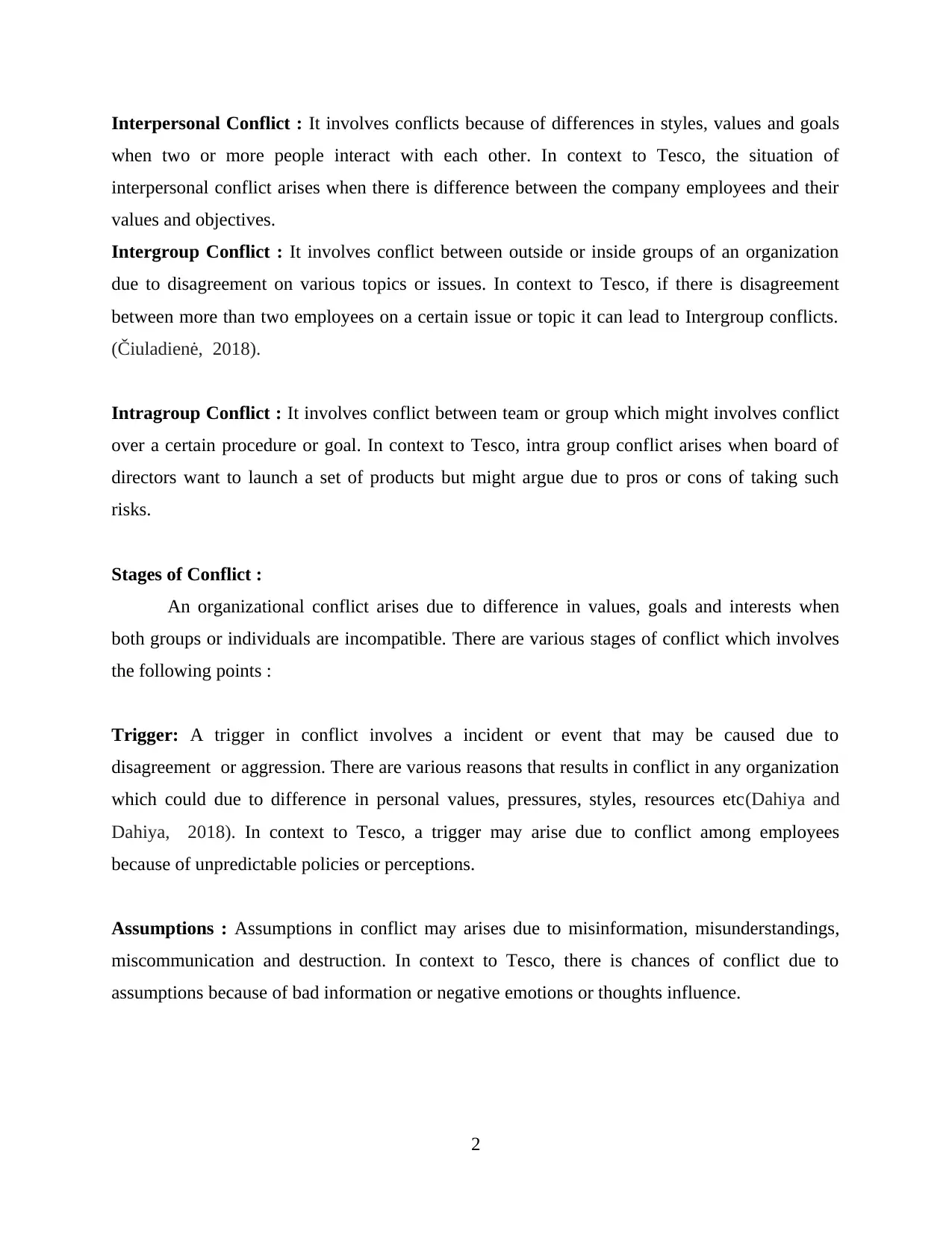
Interpersonal Conflict : It involves conflicts because of differences in styles, values and goals
when two or more people interact with each other. In context to Tesco, the situation of
interpersonal conflict arises when there is difference between the company employees and their
values and objectives.
Intergroup Conflict : It involves conflict between outside or inside groups of an organization
due to disagreement on various topics or issues. In context to Tesco, if there is disagreement
between more than two employees on a certain issue or topic it can lead to Intergroup conflicts.
(Čiuladienė, 2018).
Intragroup Conflict : It involves conflict between team or group which might involves conflict
over a certain procedure or goal. In context to Tesco, intra group conflict arises when board of
directors want to launch a set of products but might argue due to pros or cons of taking such
risks.
Stages of Conflict :
An organizational conflict arises due to difference in values, goals and interests when
both groups or individuals are incompatible. There are various stages of conflict which involves
the following points :
Trigger: A trigger in conflict involves a incident or event that may be caused due to
disagreement or aggression. There are various reasons that results in conflict in any organization
which could due to difference in personal values, pressures, styles, resources etc(Dahiya and
Dahiya, 2018). In context to Tesco, a trigger may arise due to conflict among employees
because of unpredictable policies or perceptions.
Assumptions : Assumptions in conflict may arises due to misinformation, misunderstandings,
miscommunication and destruction. In context to Tesco, there is chances of conflict due to
assumptions because of bad information or negative emotions or thoughts influence.
2
when two or more people interact with each other. In context to Tesco, the situation of
interpersonal conflict arises when there is difference between the company employees and their
values and objectives.
Intergroup Conflict : It involves conflict between outside or inside groups of an organization
due to disagreement on various topics or issues. In context to Tesco, if there is disagreement
between more than two employees on a certain issue or topic it can lead to Intergroup conflicts.
(Čiuladienė, 2018).
Intragroup Conflict : It involves conflict between team or group which might involves conflict
over a certain procedure or goal. In context to Tesco, intra group conflict arises when board of
directors want to launch a set of products but might argue due to pros or cons of taking such
risks.
Stages of Conflict :
An organizational conflict arises due to difference in values, goals and interests when
both groups or individuals are incompatible. There are various stages of conflict which involves
the following points :
Trigger: A trigger in conflict involves a incident or event that may be caused due to
disagreement or aggression. There are various reasons that results in conflict in any organization
which could due to difference in personal values, pressures, styles, resources etc(Dahiya and
Dahiya, 2018). In context to Tesco, a trigger may arise due to conflict among employees
because of unpredictable policies or perceptions.
Assumptions : Assumptions in conflict may arises due to misinformation, misunderstandings,
miscommunication and destruction. In context to Tesco, there is chances of conflict due to
assumptions because of bad information or negative emotions or thoughts influence.
2
Paraphrase This Document
Need a fresh take? Get an instant paraphrase of this document with our AI Paraphraser
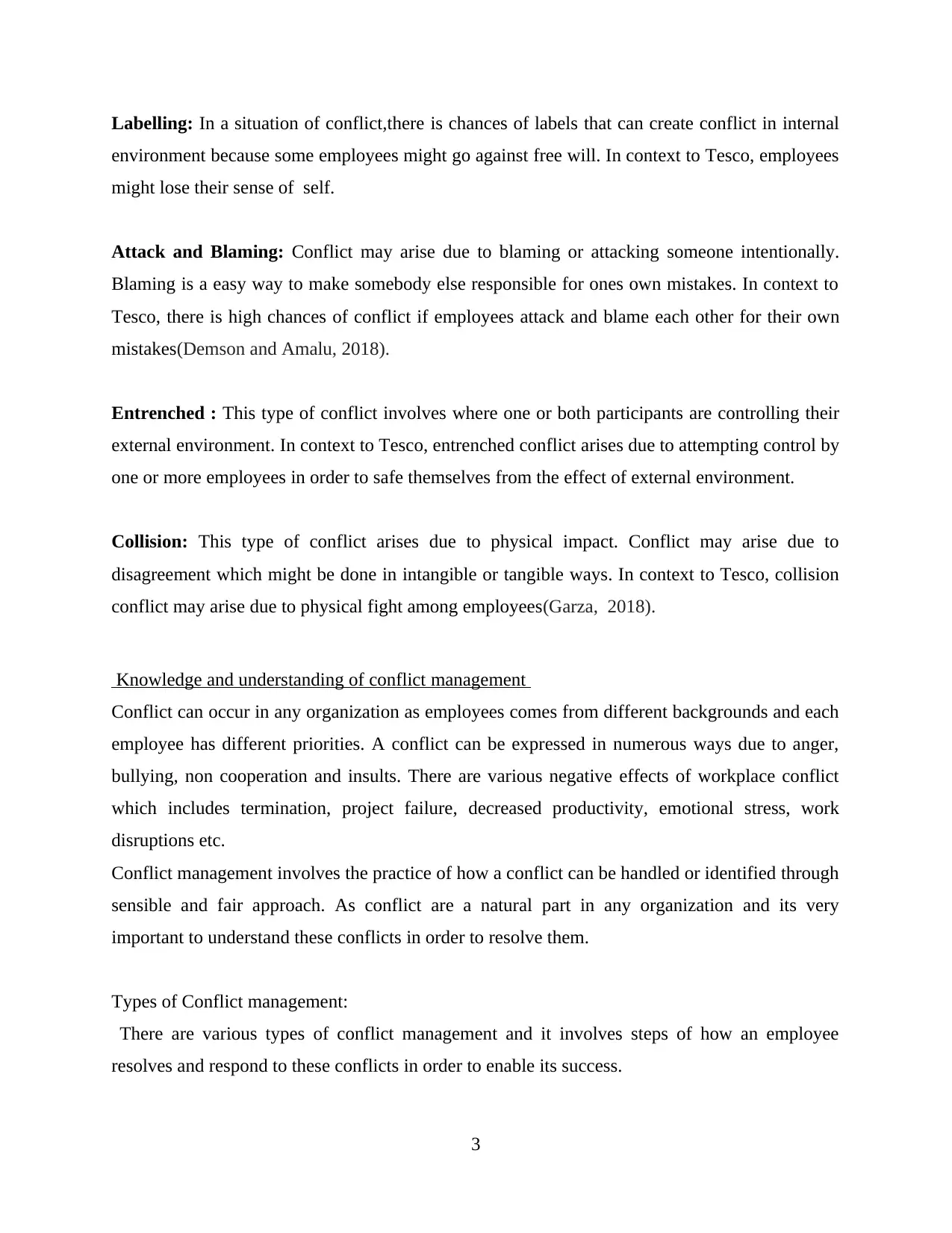
Labelling: In a situation of conflict,there is chances of labels that can create conflict in internal
environment because some employees might go against free will. In context to Tesco, employees
might lose their sense of self.
Attack and Blaming: Conflict may arise due to blaming or attacking someone intentionally.
Blaming is a easy way to make somebody else responsible for ones own mistakes. In context to
Tesco, there is high chances of conflict if employees attack and blame each other for their own
mistakes(Demson and Amalu, 2018).
Entrenched : This type of conflict involves where one or both participants are controlling their
external environment. In context to Tesco, entrenched conflict arises due to attempting control by
one or more employees in order to safe themselves from the effect of external environment.
Collision: This type of conflict arises due to physical impact. Conflict may arise due to
disagreement which might be done in intangible or tangible ways. In context to Tesco, collision
conflict may arise due to physical fight among employees(Garza, 2018).
Knowledge and understanding of conflict management
Conflict can occur in any organization as employees comes from different backgrounds and each
employee has different priorities. A conflict can be expressed in numerous ways due to anger,
bullying, non cooperation and insults. There are various negative effects of workplace conflict
which includes termination, project failure, decreased productivity, emotional stress, work
disruptions etc.
Conflict management involves the practice of how a conflict can be handled or identified through
sensible and fair approach. As conflict are a natural part in any organization and its very
important to understand these conflicts in order to resolve them.
Types of Conflict management:
There are various types of conflict management and it involves steps of how an employee
resolves and respond to these conflicts in order to enable its success.
3
environment because some employees might go against free will. In context to Tesco, employees
might lose their sense of self.
Attack and Blaming: Conflict may arise due to blaming or attacking someone intentionally.
Blaming is a easy way to make somebody else responsible for ones own mistakes. In context to
Tesco, there is high chances of conflict if employees attack and blame each other for their own
mistakes(Demson and Amalu, 2018).
Entrenched : This type of conflict involves where one or both participants are controlling their
external environment. In context to Tesco, entrenched conflict arises due to attempting control by
one or more employees in order to safe themselves from the effect of external environment.
Collision: This type of conflict arises due to physical impact. Conflict may arise due to
disagreement which might be done in intangible or tangible ways. In context to Tesco, collision
conflict may arise due to physical fight among employees(Garza, 2018).
Knowledge and understanding of conflict management
Conflict can occur in any organization as employees comes from different backgrounds and each
employee has different priorities. A conflict can be expressed in numerous ways due to anger,
bullying, non cooperation and insults. There are various negative effects of workplace conflict
which includes termination, project failure, decreased productivity, emotional stress, work
disruptions etc.
Conflict management involves the practice of how a conflict can be handled or identified through
sensible and fair approach. As conflict are a natural part in any organization and its very
important to understand these conflicts in order to resolve them.
Types of Conflict management:
There are various types of conflict management and it involves steps of how an employee
resolves and respond to these conflicts in order to enable its success.
3
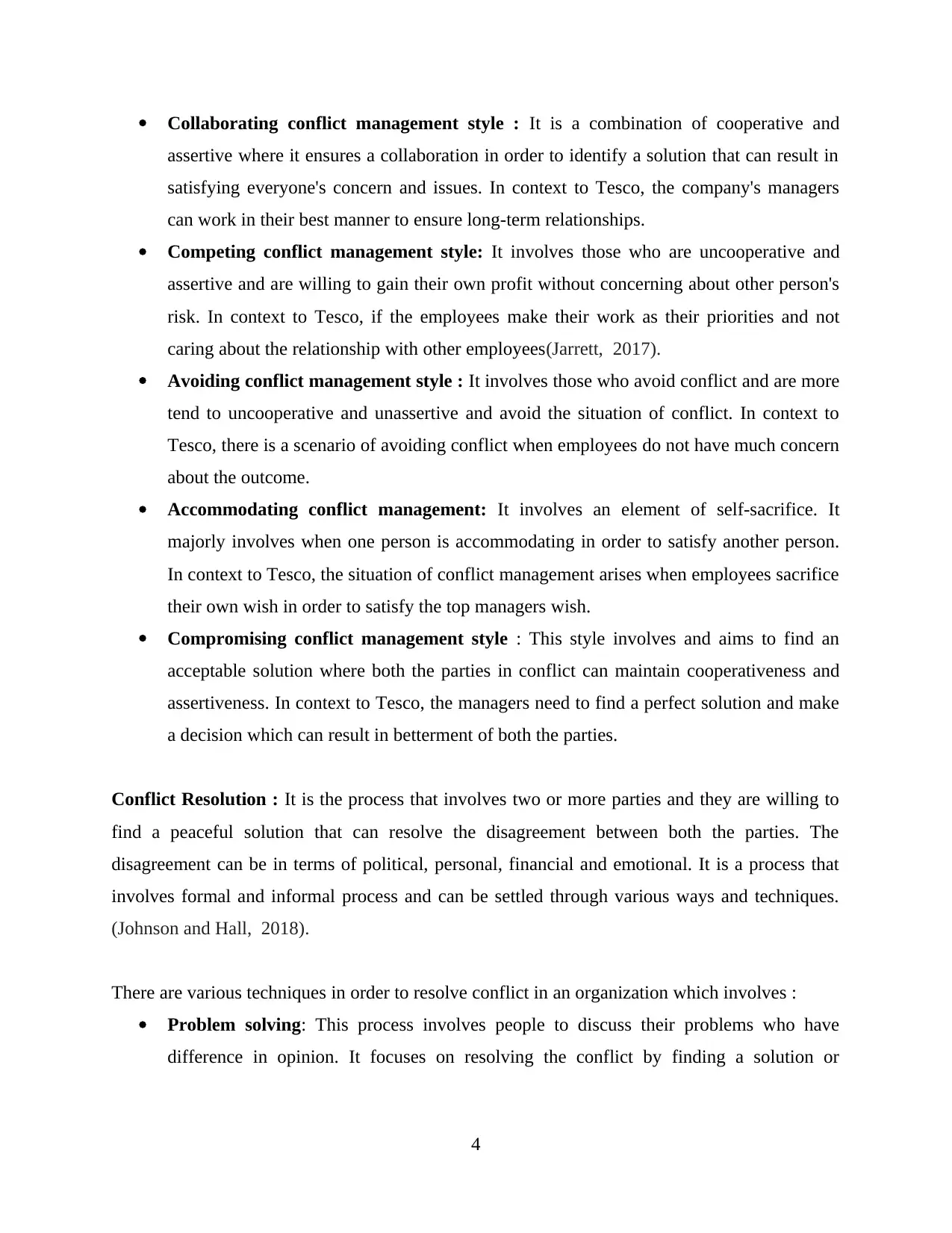
Collaborating conflict management style : It is a combination of cooperative and
assertive where it ensures a collaboration in order to identify a solution that can result in
satisfying everyone's concern and issues. In context to Tesco, the company's managers
can work in their best manner to ensure long-term relationships.
Competing conflict management style: It involves those who are uncooperative and
assertive and are willing to gain their own profit without concerning about other person's
risk. In context to Tesco, if the employees make their work as their priorities and not
caring about the relationship with other employees(Jarrett, 2017).
Avoiding conflict management style : It involves those who avoid conflict and are more
tend to uncooperative and unassertive and avoid the situation of conflict. In context to
Tesco, there is a scenario of avoiding conflict when employees do not have much concern
about the outcome.
Accommodating conflict management: It involves an element of self-sacrifice. It
majorly involves when one person is accommodating in order to satisfy another person.
In context to Tesco, the situation of conflict management arises when employees sacrifice
their own wish in order to satisfy the top managers wish.
Compromising conflict management style : This style involves and aims to find an
acceptable solution where both the parties in conflict can maintain cooperativeness and
assertiveness. In context to Tesco, the managers need to find a perfect solution and make
a decision which can result in betterment of both the parties.
Conflict Resolution : It is the process that involves two or more parties and they are willing to
find a peaceful solution that can resolve the disagreement between both the parties. The
disagreement can be in terms of political, personal, financial and emotional. It is a process that
involves formal and informal process and can be settled through various ways and techniques.
(Johnson and Hall, 2018).
There are various techniques in order to resolve conflict in an organization which involves :
Problem solving: This process involves people to discuss their problems who have
difference in opinion. It focuses on resolving the conflict by finding a solution or
4
assertive where it ensures a collaboration in order to identify a solution that can result in
satisfying everyone's concern and issues. In context to Tesco, the company's managers
can work in their best manner to ensure long-term relationships.
Competing conflict management style: It involves those who are uncooperative and
assertive and are willing to gain their own profit without concerning about other person's
risk. In context to Tesco, if the employees make their work as their priorities and not
caring about the relationship with other employees(Jarrett, 2017).
Avoiding conflict management style : It involves those who avoid conflict and are more
tend to uncooperative and unassertive and avoid the situation of conflict. In context to
Tesco, there is a scenario of avoiding conflict when employees do not have much concern
about the outcome.
Accommodating conflict management: It involves an element of self-sacrifice. It
majorly involves when one person is accommodating in order to satisfy another person.
In context to Tesco, the situation of conflict management arises when employees sacrifice
their own wish in order to satisfy the top managers wish.
Compromising conflict management style : This style involves and aims to find an
acceptable solution where both the parties in conflict can maintain cooperativeness and
assertiveness. In context to Tesco, the managers need to find a perfect solution and make
a decision which can result in betterment of both the parties.
Conflict Resolution : It is the process that involves two or more parties and they are willing to
find a peaceful solution that can resolve the disagreement between both the parties. The
disagreement can be in terms of political, personal, financial and emotional. It is a process that
involves formal and informal process and can be settled through various ways and techniques.
(Johnson and Hall, 2018).
There are various techniques in order to resolve conflict in an organization which involves :
Problem solving: This process involves people to discuss their problems who have
difference in opinion. It focuses on resolving the conflict by finding a solution or
4
⊘ This is a preview!⊘
Do you want full access?
Subscribe today to unlock all pages.

Trusted by 1+ million students worldwide
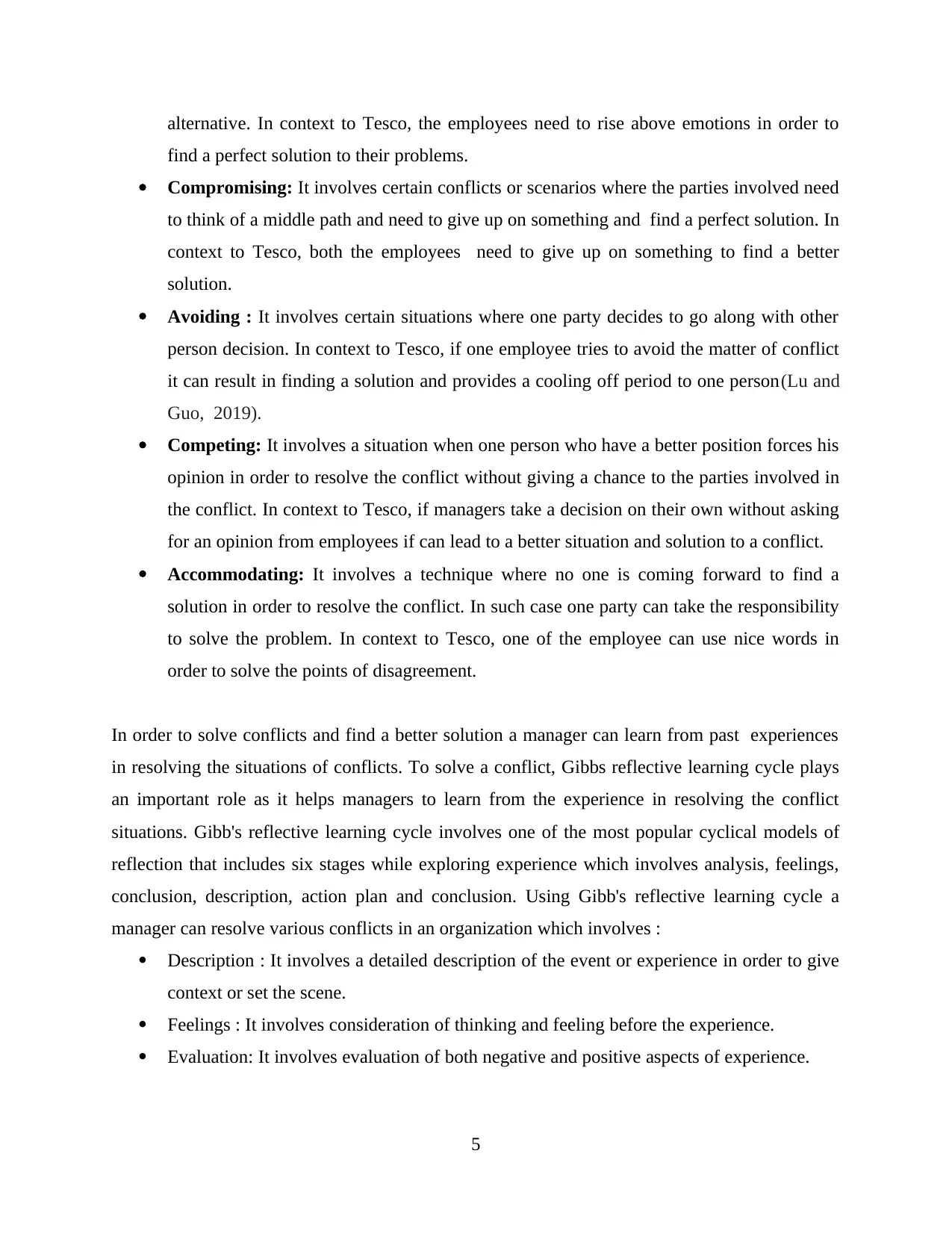
alternative. In context to Tesco, the employees need to rise above emotions in order to
find a perfect solution to their problems.
Compromising: It involves certain conflicts or scenarios where the parties involved need
to think of a middle path and need to give up on something and find a perfect solution. In
context to Tesco, both the employees need to give up on something to find a better
solution.
Avoiding : It involves certain situations where one party decides to go along with other
person decision. In context to Tesco, if one employee tries to avoid the matter of conflict
it can result in finding a solution and provides a cooling off period to one person(Lu and
Guo, 2019).
Competing: It involves a situation when one person who have a better position forces his
opinion in order to resolve the conflict without giving a chance to the parties involved in
the conflict. In context to Tesco, if managers take a decision on their own without asking
for an opinion from employees if can lead to a better situation and solution to a conflict.
Accommodating: It involves a technique where no one is coming forward to find a
solution in order to resolve the conflict. In such case one party can take the responsibility
to solve the problem. In context to Tesco, one of the employee can use nice words in
order to solve the points of disagreement.
In order to solve conflicts and find a better solution a manager can learn from past experiences
in resolving the situations of conflicts. To solve a conflict, Gibbs reflective learning cycle plays
an important role as it helps managers to learn from the experience in resolving the conflict
situations. Gibb's reflective learning cycle involves one of the most popular cyclical models of
reflection that includes six stages while exploring experience which involves analysis, feelings,
conclusion, description, action plan and conclusion. Using Gibb's reflective learning cycle a
manager can resolve various conflicts in an organization which involves :
Description : It involves a detailed description of the event or experience in order to give
context or set the scene.
Feelings : It involves consideration of thinking and feeling before the experience.
Evaluation: It involves evaluation of both negative and positive aspects of experience.
5
find a perfect solution to their problems.
Compromising: It involves certain conflicts or scenarios where the parties involved need
to think of a middle path and need to give up on something and find a perfect solution. In
context to Tesco, both the employees need to give up on something to find a better
solution.
Avoiding : It involves certain situations where one party decides to go along with other
person decision. In context to Tesco, if one employee tries to avoid the matter of conflict
it can result in finding a solution and provides a cooling off period to one person(Lu and
Guo, 2019).
Competing: It involves a situation when one person who have a better position forces his
opinion in order to resolve the conflict without giving a chance to the parties involved in
the conflict. In context to Tesco, if managers take a decision on their own without asking
for an opinion from employees if can lead to a better situation and solution to a conflict.
Accommodating: It involves a technique where no one is coming forward to find a
solution in order to resolve the conflict. In such case one party can take the responsibility
to solve the problem. In context to Tesco, one of the employee can use nice words in
order to solve the points of disagreement.
In order to solve conflicts and find a better solution a manager can learn from past experiences
in resolving the situations of conflicts. To solve a conflict, Gibbs reflective learning cycle plays
an important role as it helps managers to learn from the experience in resolving the conflict
situations. Gibb's reflective learning cycle involves one of the most popular cyclical models of
reflection that includes six stages while exploring experience which involves analysis, feelings,
conclusion, description, action plan and conclusion. Using Gibb's reflective learning cycle a
manager can resolve various conflicts in an organization which involves :
Description : It involves a detailed description of the event or experience in order to give
context or set the scene.
Feelings : It involves consideration of thinking and feeling before the experience.
Evaluation: It involves evaluation of both negative and positive aspects of experience.
5
Paraphrase This Document
Need a fresh take? Get an instant paraphrase of this document with our AI Paraphraser
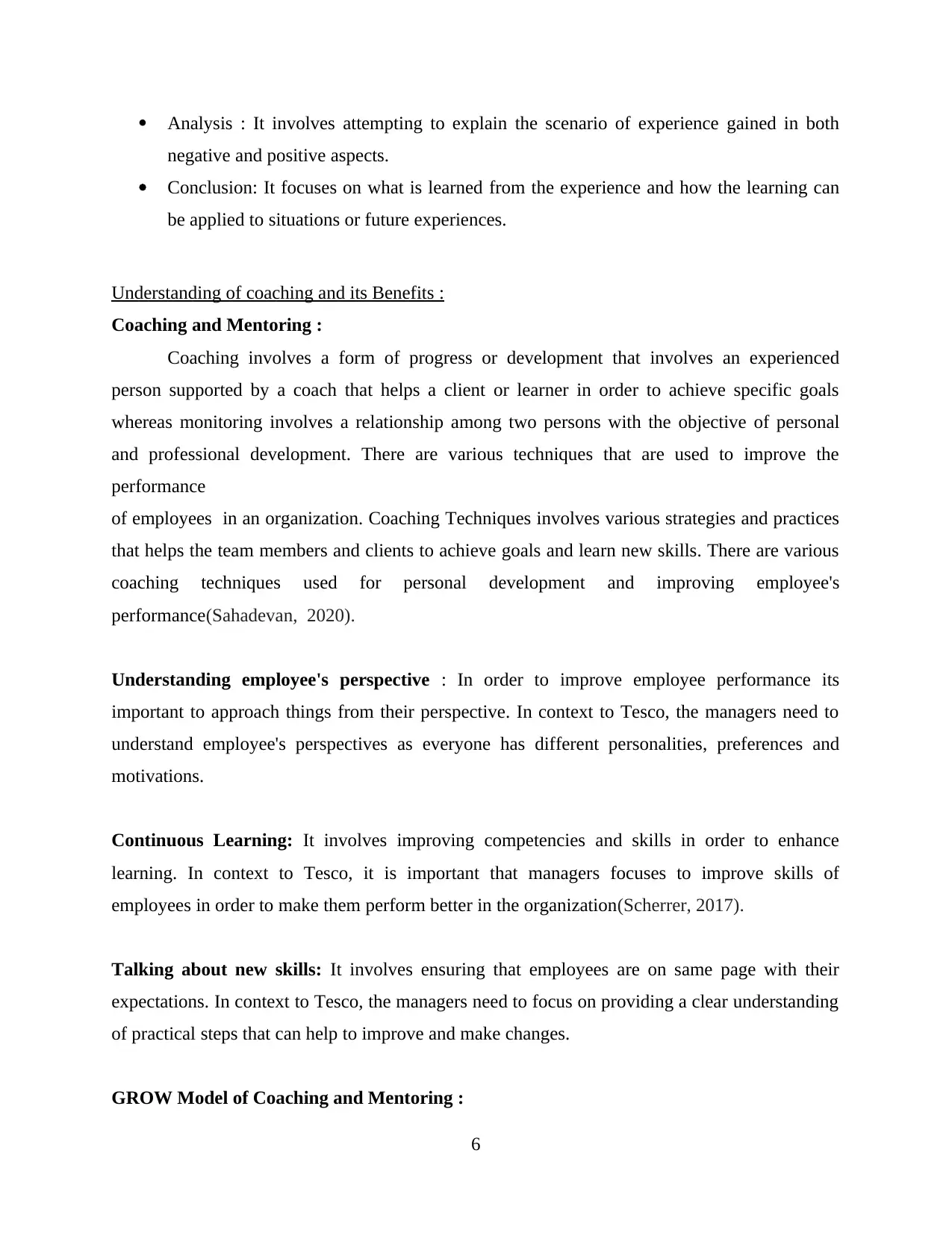
Analysis : It involves attempting to explain the scenario of experience gained in both
negative and positive aspects.
Conclusion: It focuses on what is learned from the experience and how the learning can
be applied to situations or future experiences.
Understanding of coaching and its Benefits :
Coaching and Mentoring :
Coaching involves a form of progress or development that involves an experienced
person supported by a coach that helps a client or learner in order to achieve specific goals
whereas monitoring involves a relationship among two persons with the objective of personal
and professional development. There are various techniques that are used to improve the
performance
of employees in an organization. Coaching Techniques involves various strategies and practices
that helps the team members and clients to achieve goals and learn new skills. There are various
coaching techniques used for personal development and improving employee's
performance(Sahadevan, 2020).
Understanding employee's perspective : In order to improve employee performance its
important to approach things from their perspective. In context to Tesco, the managers need to
understand employee's perspectives as everyone has different personalities, preferences and
motivations.
Continuous Learning: It involves improving competencies and skills in order to enhance
learning. In context to Tesco, it is important that managers focuses to improve skills of
employees in order to make them perform better in the organization(Scherrer, 2017).
Talking about new skills: It involves ensuring that employees are on same page with their
expectations. In context to Tesco, the managers need to focus on providing a clear understanding
of practical steps that can help to improve and make changes.
GROW Model of Coaching and Mentoring :
6
negative and positive aspects.
Conclusion: It focuses on what is learned from the experience and how the learning can
be applied to situations or future experiences.
Understanding of coaching and its Benefits :
Coaching and Mentoring :
Coaching involves a form of progress or development that involves an experienced
person supported by a coach that helps a client or learner in order to achieve specific goals
whereas monitoring involves a relationship among two persons with the objective of personal
and professional development. There are various techniques that are used to improve the
performance
of employees in an organization. Coaching Techniques involves various strategies and practices
that helps the team members and clients to achieve goals and learn new skills. There are various
coaching techniques used for personal development and improving employee's
performance(Sahadevan, 2020).
Understanding employee's perspective : In order to improve employee performance its
important to approach things from their perspective. In context to Tesco, the managers need to
understand employee's perspectives as everyone has different personalities, preferences and
motivations.
Continuous Learning: It involves improving competencies and skills in order to enhance
learning. In context to Tesco, it is important that managers focuses to improve skills of
employees in order to make them perform better in the organization(Scherrer, 2017).
Talking about new skills: It involves ensuring that employees are on same page with their
expectations. In context to Tesco, the managers need to focus on providing a clear understanding
of practical steps that can help to improve and make changes.
GROW Model of Coaching and Mentoring :
6
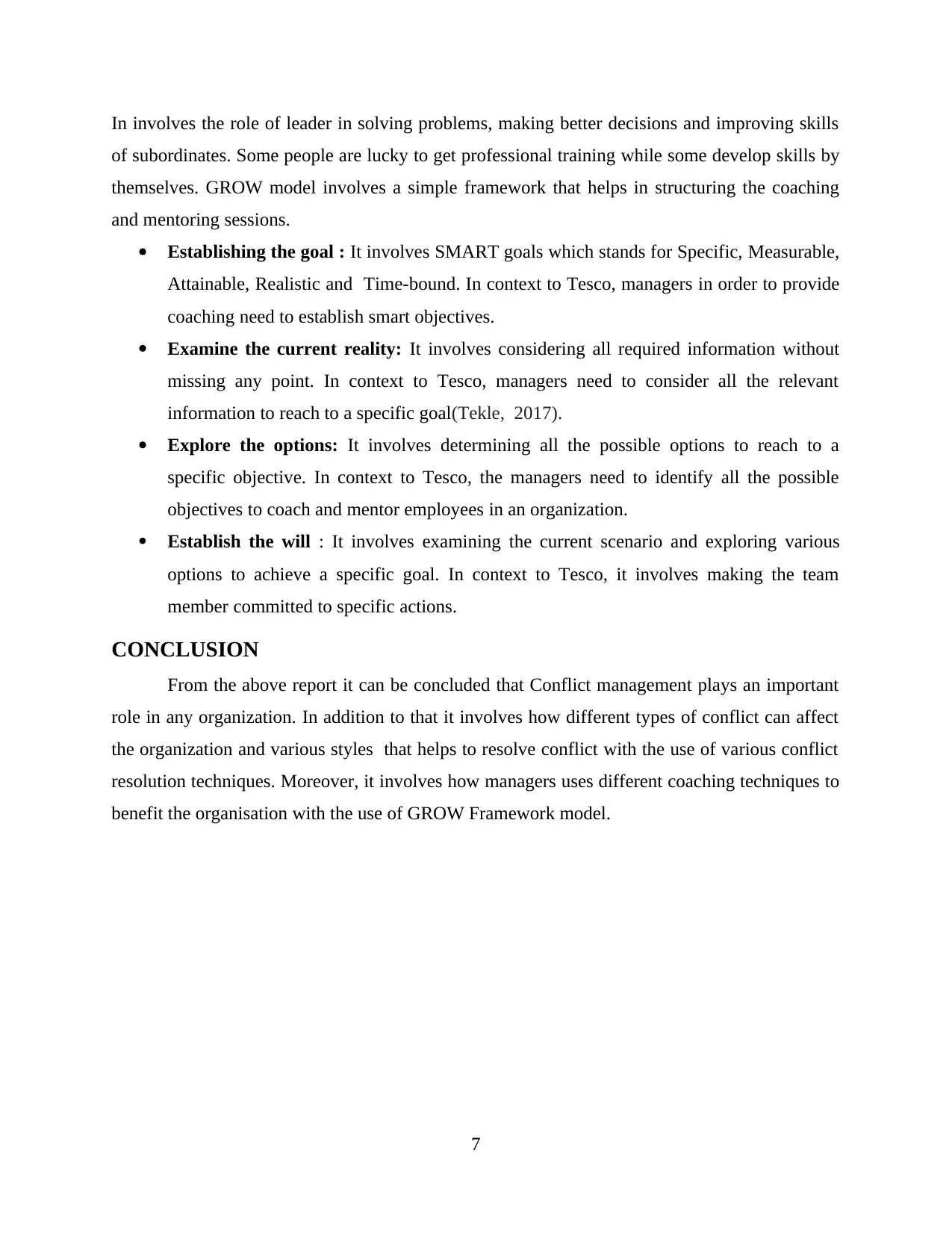
In involves the role of leader in solving problems, making better decisions and improving skills
of subordinates. Some people are lucky to get professional training while some develop skills by
themselves. GROW model involves a simple framework that helps in structuring the coaching
and mentoring sessions.
Establishing the goal : It involves SMART goals which stands for Specific, Measurable,
Attainable, Realistic and Time-bound. In context to Tesco, managers in order to provide
coaching need to establish smart objectives.
Examine the current reality: It involves considering all required information without
missing any point. In context to Tesco, managers need to consider all the relevant
information to reach to a specific goal(Tekle, 2017).
Explore the options: It involves determining all the possible options to reach to a
specific objective. In context to Tesco, the managers need to identify all the possible
objectives to coach and mentor employees in an organization.
Establish the will : It involves examining the current scenario and exploring various
options to achieve a specific goal. In context to Tesco, it involves making the team
member committed to specific actions.
CONCLUSION
From the above report it can be concluded that Conflict management plays an important
role in any organization. In addition to that it involves how different types of conflict can affect
the organization and various styles that helps to resolve conflict with the use of various conflict
resolution techniques. Moreover, it involves how managers uses different coaching techniques to
benefit the organisation with the use of GROW Framework model.
7
of subordinates. Some people are lucky to get professional training while some develop skills by
themselves. GROW model involves a simple framework that helps in structuring the coaching
and mentoring sessions.
Establishing the goal : It involves SMART goals which stands for Specific, Measurable,
Attainable, Realistic and Time-bound. In context to Tesco, managers in order to provide
coaching need to establish smart objectives.
Examine the current reality: It involves considering all required information without
missing any point. In context to Tesco, managers need to consider all the relevant
information to reach to a specific goal(Tekle, 2017).
Explore the options: It involves determining all the possible options to reach to a
specific objective. In context to Tesco, the managers need to identify all the possible
objectives to coach and mentor employees in an organization.
Establish the will : It involves examining the current scenario and exploring various
options to achieve a specific goal. In context to Tesco, it involves making the team
member committed to specific actions.
CONCLUSION
From the above report it can be concluded that Conflict management plays an important
role in any organization. In addition to that it involves how different types of conflict can affect
the organization and various styles that helps to resolve conflict with the use of various conflict
resolution techniques. Moreover, it involves how managers uses different coaching techniques to
benefit the organisation with the use of GROW Framework model.
7
⊘ This is a preview!⊘
Do you want full access?
Subscribe today to unlock all pages.

Trusted by 1+ million students worldwide
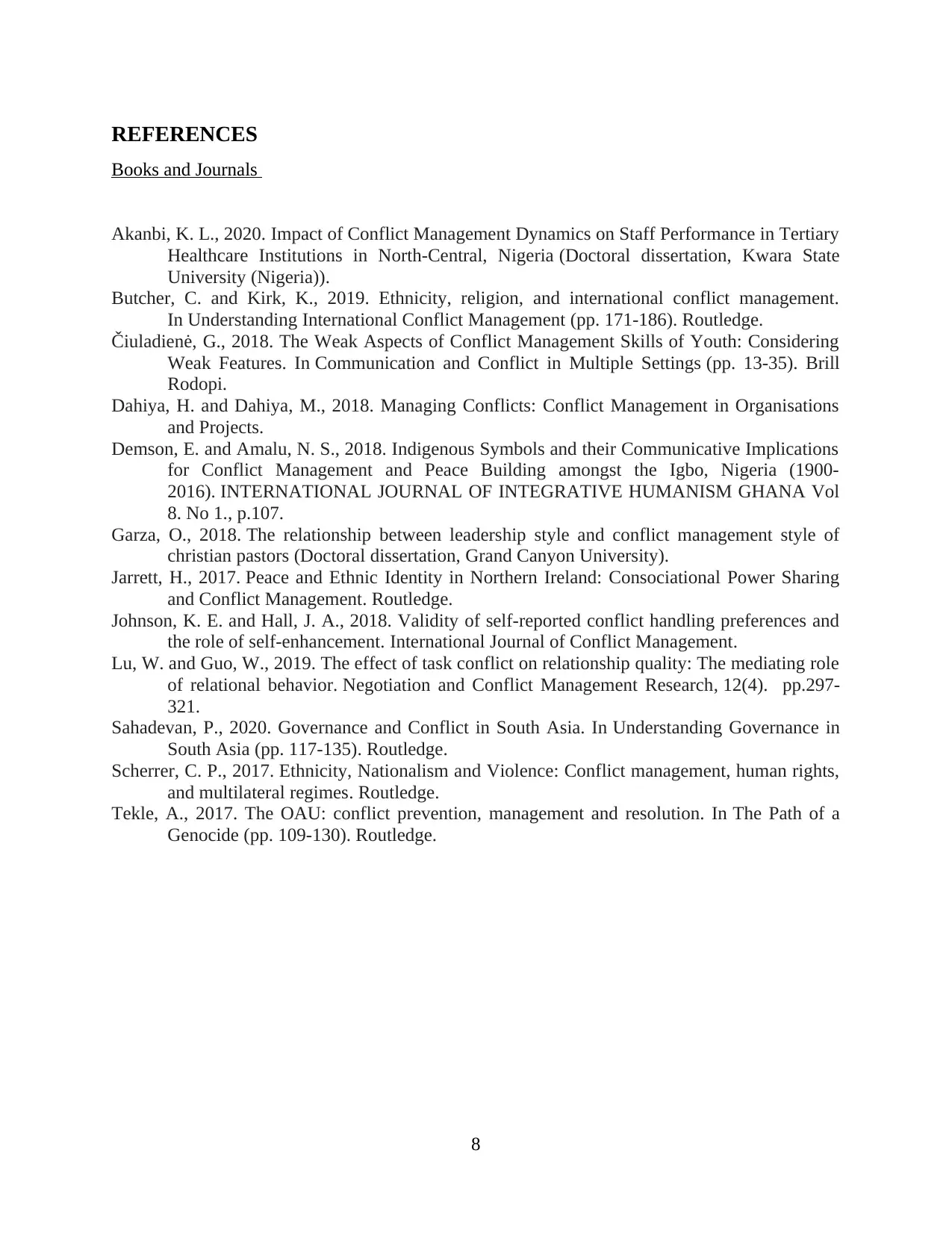
REFERENCES
Books and Journals
Akanbi, K. L., 2020. Impact of Conflict Management Dynamics on Staff Performance in Tertiary
Healthcare Institutions in North-Central, Nigeria (Doctoral dissertation, Kwara State
University (Nigeria)).
Butcher, C. and Kirk, K., 2019. Ethnicity, religion, and international conflict management.
In Understanding International Conflict Management (pp. 171-186). Routledge.
Čiuladienė, G., 2018. The Weak Aspects of Conflict Management Skills of Youth: Considering
Weak Features. In Communication and Conflict in Multiple Settings (pp. 13-35). Brill
Rodopi.
Dahiya, H. and Dahiya, M., 2018. Managing Conflicts: Conflict Management in Organisations
and Projects.
Demson, E. and Amalu, N. S., 2018. Indigenous Symbols and their Communicative Implications
for Conflict Management and Peace Building amongst the Igbo, Nigeria (1900-
2016). INTERNATIONAL JOURNAL OF INTEGRATIVE HUMANISM GHANA Vol
8. No 1., p.107.
Garza, O., 2018. The relationship between leadership style and conflict management style of
christian pastors (Doctoral dissertation, Grand Canyon University).
Jarrett, H., 2017. Peace and Ethnic Identity in Northern Ireland: Consociational Power Sharing
and Conflict Management. Routledge.
Johnson, K. E. and Hall, J. A., 2018. Validity of self-reported conflict handling preferences and
the role of self-enhancement. International Journal of Conflict Management.
Lu, W. and Guo, W., 2019. The effect of task conflict on relationship quality: The mediating role
of relational behavior. Negotiation and Conflict Management Research, 12(4). pp.297-
321.
Sahadevan, P., 2020. Governance and Conflict in South Asia. In Understanding Governance in
South Asia (pp. 117-135). Routledge.
Scherrer, C. P., 2017. Ethnicity, Nationalism and Violence: Conflict management, human rights,
and multilateral regimes. Routledge.
Tekle, A., 2017. The OAU: conflict prevention, management and resolution. In The Path of a
Genocide (pp. 109-130). Routledge.
8
Books and Journals
Akanbi, K. L., 2020. Impact of Conflict Management Dynamics on Staff Performance in Tertiary
Healthcare Institutions in North-Central, Nigeria (Doctoral dissertation, Kwara State
University (Nigeria)).
Butcher, C. and Kirk, K., 2019. Ethnicity, religion, and international conflict management.
In Understanding International Conflict Management (pp. 171-186). Routledge.
Čiuladienė, G., 2018. The Weak Aspects of Conflict Management Skills of Youth: Considering
Weak Features. In Communication and Conflict in Multiple Settings (pp. 13-35). Brill
Rodopi.
Dahiya, H. and Dahiya, M., 2018. Managing Conflicts: Conflict Management in Organisations
and Projects.
Demson, E. and Amalu, N. S., 2018. Indigenous Symbols and their Communicative Implications
for Conflict Management and Peace Building amongst the Igbo, Nigeria (1900-
2016). INTERNATIONAL JOURNAL OF INTEGRATIVE HUMANISM GHANA Vol
8. No 1., p.107.
Garza, O., 2018. The relationship between leadership style and conflict management style of
christian pastors (Doctoral dissertation, Grand Canyon University).
Jarrett, H., 2017. Peace and Ethnic Identity in Northern Ireland: Consociational Power Sharing
and Conflict Management. Routledge.
Johnson, K. E. and Hall, J. A., 2018. Validity of self-reported conflict handling preferences and
the role of self-enhancement. International Journal of Conflict Management.
Lu, W. and Guo, W., 2019. The effect of task conflict on relationship quality: The mediating role
of relational behavior. Negotiation and Conflict Management Research, 12(4). pp.297-
321.
Sahadevan, P., 2020. Governance and Conflict in South Asia. In Understanding Governance in
South Asia (pp. 117-135). Routledge.
Scherrer, C. P., 2017. Ethnicity, Nationalism and Violence: Conflict management, human rights,
and multilateral regimes. Routledge.
Tekle, A., 2017. The OAU: conflict prevention, management and resolution. In The Path of a
Genocide (pp. 109-130). Routledge.
8
Paraphrase This Document
Need a fresh take? Get an instant paraphrase of this document with our AI Paraphraser

9
1 out of 11
Related Documents
Your All-in-One AI-Powered Toolkit for Academic Success.
+13062052269
info@desklib.com
Available 24*7 on WhatsApp / Email
![[object Object]](/_next/static/media/star-bottom.7253800d.svg)
Unlock your academic potential
Copyright © 2020–2025 A2Z Services. All Rights Reserved. Developed and managed by ZUCOL.





